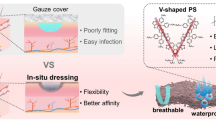Abstract
In the viewpoint of biomaterials, hydrogel has been established as a structure with straightforward fabrication and widespread applications; however, when it comes to practical use, for instance being under mechanical stress or carrying medicinal agents, different treatments may be required. Here, the interest is limited to the hydrogel of chitosan, finding out to what extent PCL nanofibers mixed in the hydrogel affect the hydrogel properties. The resultant structure is named hybrid. The mixing is carried out through two approaches: the first concerns mixing 1×1 mm2 nanofibrous layers into the hydrogel solution (HM), and the other deals with a hydrogel comprising a single layer of the nanofibrous mat spread within it (LbL). The results indicates that the inclusion of the nanofibers enhances the mechanical properties of the hydrogel. In terms of water absorption, the results demonstrate that HM samples absorb up to 2.5-fold compared with the neat hydrogel, whereas the LbL approach reduces this feature. Furthermore, the HM approach speeds up the degradability rate, while the LbL lowers. The MTS assay demonstrates appropriate growth of the human fibroblast cells. Although the results hold promise for this hybrid as wound dressing, more efforts still ought to be performed to reach satisfactory products.
Similar content being viewed by others
References
H. Y. Zhou, L. J. Jiang, P. P. Cao, J. B. Li, and X. G. Chen, Carbohydr. Polym., 117, 524 (2015).
A. Suzuki and S. Sasaki, Proc. Inst. Mech. Eng. H., 229, 828 (2015).
S. Dhivya, V. V. Padma, and E. Santhini, Biomedicine, 5, 24 (2015).
M. F. Akhtar, M. Hanif, and N. M. Ranjha, Saudi Pharm. J., 24, 554 (2016).
S. Islam, M. A. R. Bhuiyan, and M. N. Islam, J. Polym. Environ., 25, 854 (2017).
W. Mozalewska, R. Czechowska-Biskup, A. K. Olejnik, R. A. Wach, P. Ulański, and J. M. Rosiak, Radiat. Phys. Chem., 134, 1 (2017).
H. Hamedi, S. Moradi, S. M. Hudson, and A. E. Tonelli, Carbohydr. Polym., 199, 445 (2018).
J. Jang, H. Oh, J. Lee, T. H. Song, Y. H. Jeong, and D. W. Cho, Appl. Phys. Lett., 102, 211914 (2013).
Y. S. Zhang and A. Khademhosseini, Science, 356, 3627 (2017).
E. A. Kamoun, E. R. S. Kenawy, and X. Chen, J. Adv. Res., 8, 217 (2017).
S. Xu, L. Deng, J. Zhang, L. Yin, and A. Dong, J. Biomed. Mater. Res. Part B Appl. Biomater., 104, 640 (2016).
R. Wu, R. A. Niamat, B. Sansbury, and M. Borjigin, Fibers, 3, 296 (2015).
Q. Fu, C. Duan, Z. Yan, Y. Li, Y. Si, L. Liu, J. Yu, and B. Ding, Macromol. Rapid Commun., 39, 1800058 (2018).
P. Falamarzpour, T. Behzad, and A. Zamani, Int. J. Mol. Sci., 18, 396 (2017).
G. Lawrie, I. Keen, B. Drew, A. Chandler-Temple, L. Rintoul, P. Fredericks, and L. Grøndahl, Biomacromolecules, 8, 2533 (2007).
Digimizer Image Analysis Software Version 5 (MedCalc Software bv, Ostend, Belgium; https://www.digimizer.com (Accessed March 23, 2021).
J. Noroozi, C. Ghotbi, J. J. Sardroodi, J. Karimi-Sabet, and M. A. Robert, J. Supercrit. Fluids, 109, 166 (2016).
V. Pillay, C. Dott, Y. E. Choonara, C. Tyagi, L. Tomar, P. Kumar, L. C. Du Toit, and V. M. K. Ndesendo, J. Nanomater, 2013, 789289 (2013).
C. Zhou and Q. Wu, Colloids Surfaces B Biointerfaces, 84, 155 (2011).
Z. Peng, Z. Peng, and Y. Shen, Polym.-Plast. Technol. Eng., 50, 1160 (2011).
O. A. C. Monteiro Jr. and C. Airoldi, Int. J. Biol. Macromol., 26, 119 (1999).
N. R. Kildeeva, P. A. Perminov, L. V. Vladimirov, V. V. Novikov, and S. N. Mikhailov, Russ. J. Bioorganic Chem., 35, 360 (2009).
L. Poon, L. D. Wilson, and J. V. Headley, Carbohydr. Polym., 109, 92 (2014).
B. C. Smith, Spectrosc. (Santa Monica), 32, 14 (2017).
B. C. Smith, Spectrosc. (Santa Monica), 32, 19 (2017).
A. Lesbani, F. Fitriliana, and R. Mohadi, Indones. J. Chem., 15, 64 (2015).
B. C. Smith, Spectrosc. (Santa Monica), 33, 20 (2018).
J. Zhao and J. Wang, J. Phys. Chem. B, 119, 14831 (2015).
R. Borah and A. Kumar, Mater. Sci. Eng. C, 61, 762 (2016).
K. P. C. Vollhardt and N. E. Schore, “Organic Chemistry: Structure and Function”, 6th ed., pp.797–798, W. H. Freeman and Company, New York, 2011.
L. Xu, S. Hua, and S. Li, Chem. Commun., 49, 1542 (2013).
M. Islam, M. Razzak, M. Karim, and A. H. Mirza, Tetrahedron Lett., 58, 1429 (2017).
A. Kwiecień and Z. Ciunik, Molecules, 20, 14365 (2015).
M. Hejazi, T. Behzad, P. Heidarian, and B. Nasri-Nasrabadi, Compos. Part A Appl. Sci. Manuf., 109, 221 (2018).
Y. Lu, A. A. Armentrout, J. Li, H. L. Tekinalp, J. Nanda, and S. Ozcan, J. Mater. Chem. A, 3, 13350 (2015).
Z. Xu, J. Li, H. Zhou, X. Jiang, C. Yang, and F. Wang, RSC Adv., 6, 43626 (2016).
N. Han, J. Johnson, J. J. Lannutti, and J. O. Winter, J. Control. Release, 158, 165 (2012).
Author information
Authors and Affiliations
Corresponding author
Electronic supplementary material
12221_2021_283_MOESM1_ESM.pdf
Fabrication and Characterization of a Hybrid Structure Comprising Chitosan Hydrogel and PCL Nanofibers for Potential Application in Wound Dressing
Rights and permissions
About this article
Cite this article
Safamehr, A., Ghasemi-Mobarakeh, L., Mansurnezhad, R. et al. Fabrication and Characterization of a Hybrid Structure Comprising Chitosan Hydrogel and PCL Nanofibers for Potential Application in Wound Dressing. Fibers Polym 23, 366–376 (2022). https://doi.org/10.1007/s12221-021-0283-8
Received:
Revised:
Accepted:
Published:
Issue Date:
DOI: https://doi.org/10.1007/s12221-021-0283-8




